Dragon fruit is possibly the best thing nature has ever produced. The sweet, creamy fruits are as beautiful to look at as they are to eat, and you can grow them surprisingly simply throughout Australia.
Held on the flowering tips of Selenicereus cactuses, the fruits are packed full of water, and filled with seeds, tempting any passing bird, mammal, insect, or otherwise, to spread its seeds for it. To grow your own, just follow our guide to growing dragon fruit in Australia and you’ll be harvesting ripe fruit in no time.
More...
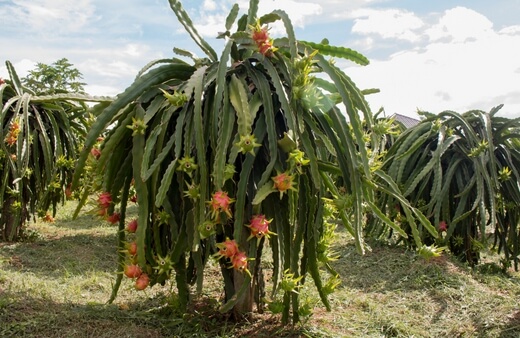
Family: | Cactaceae |
|---|---|
Genus: | Selenicereus |
Common Names: | Dragon fruit plant, Dragon fruit cactus, Pitaya, Pitahaya |
Location: | Outdoor |
Type: | Cactus |
Growth: | 2-5m tall |
Sun requirements: | Full sun |
Foliage Colour: | Green |
Flower Colour: | White & Yellow |
Flowering: | Early summer |
Fruit: | Spiny red fruits, with edible white flesh and seeds |
Maintenance level: | Medium |
Poisonous for pets: | Non-toxic to cats and dogs |
Getting to Know Dragon Fruit Plants
Dragon fruit plants (or Pitaya) are cactuses whose flowers, when pollinated, produce sweet, fleshy fruit, containing hundreds, if not thousands of tiny seeds. The fruit is an edible treat in nearly every culture and is highly cultivated in Australia, and Africa and throughout the Middle East.
The plant itself grows as a cluster of young, drooping, cactus leaves (actually stems) similar to the Easter Cactus, with rotund waves along its stems. As the dragon fruit plant stems develop, they should be tied into chunky supports to create a tree-like form that can reach up to 5m tall in some species.
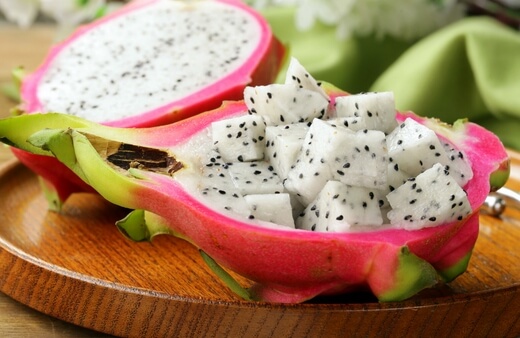
Pitaya’s Natural Habitat
Pitaya, more commonly known as the dragon fruit plant, is native to the Americas, though its specific origin is unknown. In fact, apart from one African species (Rhipsalis baccifera) every single cactus is native to the Americas, having evolved after the separation of continents.
They thrive on well-drained, sandy soil, and store water through dry or arid periods between heavy rainfalls. Recreating those conditions in some parts of Australia can be tricky, but they are successfully cultivated en masse here, and produce up to four crops per year.
What are the Benefits of Dragon Fruit?
Dragon fruits, as well as coming from beautiful plants, have some great health benefits. They are rich in vitamin C and antioxidants, but most significantly, they have high amounts of soluble fibre, which is ideal for aiding digestive problems, and supporting weight-loss targeted diets.
10 Best Dragon Fruit Varieties
There are only three species of dragon fruit, all in the genus, Selenicereus. While there are dozens more species of Selenicereus, their fruits are not sweet or palatable, so they are not generally considered dragon fruits (though they aren’t toxic).
It’s also worth noting, that some sellers may still refer to dragon fruits as Hylocereus, or Cereus, genus, but they were reclassified in the late 1900s.
The three species, which all dragon fruit cultivars are derived from are:
- Selenicereus undatus
- Selenicereus costaricensis
- Selenicereus megalanthus
Each has its own merits, but S. undatus is the main parent of most Pitaya cultivars. Key identifiers of each are the white flesh of S. undatus, the red flesh of S. costaricensis, and the yellow outer skin or S. megalanthus.
The cultivars below have been bred to include different aspects of each species, from growth rates, and ultimate heights, to fruit flavour and everything in between.
1. Dragon Fruit ‘Alice Snow’
Named after the botanist and rare fruit grower, Alice Snow, this dragon fruit is one of the most widely available for domestic cultivation. The large, white-fleshed fruits of this dragon fruit are sweet, with an ever-so-slight bitter tang, which gives them a more rounded flavour than most.
The skin is thick dayglow pink, with flashes of jade. You will need at least two plants as it requires cross-pollination to set fruit.
2. Dragon Fruit ‘David Bowie’
It’s probably not worth explaining why this slim, brightly painted fruit was named after David Bowie, but just if you’re not familiar, check out his star man face paints. You’ll know exactly why.
The large slender fruits are predominantly bred from S. undatus, with gorgeous petaling on the outer skin, and a crisp white interior. David Bowie is one of the easiest to grow at home, as it is reliably self-pollinating.
3. Dragon Fruit ‘Harpua’
Harupa, another predominantly S. undatus variety is visually similar to ‘David Bowie’, but with a fresher sweetness that doesn’t have any bitter aftertaste. For home growers looking for easy, reliable dragon fruits, there aren’t many that reach the 1 lb fruits of ‘Harupa’ at the same time as being completely self-pollinated.
4. Dragon Fruit ‘L.A. Woman.’
While ‘L.A. Woman’ requires self-pollinating and has a distinctly sour aftertaste, it’s one of the largest pitaya varieties for any garden, with fruits weighing up to 1.5lb.
However, if you’re after a sweeter, generally more useful fruit, consider growing something smaller like ‘Alice’ or ‘Harupa’.
5. Dragon Fruit ‘Physical Graffiti’
I get really excited by the ripe fruits of ‘Physical Graffiti’. Not because it’s particularly tasty (though it is!) but because there are layers to it. The green petals on the outer skin of the fruit need to be peeled away to reveal a stunning pink skin, and when sliced, the most gorgeous, delicate pink flesh is unveiled.
6. Dragon Fruit ‘Purple Haze’
Nearly all red fleshed pitayas are self-pollinating, which makes them perfect for commercial growers as well as domestic growers, without any need to worry about pollination, meaning your crop is only dependent on growing conditions to thrive.
Purple Haze is similar to Physical Graffiti, but with fewer seeds; so if you get irritated by seeds sticking between your teeth it is well worth considering.
7. Dragon Fruit ‘Thompson’
Dragon Fruit Thompson is one you’ll need to grow yourself if you ever want to try it. Despite being self-pollinating it is very rarely grown commercially, and nearly never sold in shops. This is mostly due to its thick skin and rind, which aren’t pleasant to eat, meaning it has a much lower ratio of edible flesh.
The flavour is next to nothing though, and once you taste it, you’ll seriously question the value of quantity.
8. Dragon Fruit ‘Vietnamese Jaina’
This picture-perfect dragon fruit, ‘Vietnamese Jaina’, is sweet, but without many other flavour notes. It works well as a garnish or eaten raw, but it is perhaps one of the reasons that dragon fruits have a reputation for blandness.
Self-pollination and crisp white flesh make it easy to sell, so it is one of the most exported dragon fruit varieties in the world.
9. Dragon Fruit ‘Yellow Dragon Fruit’
If you ever see a yellow dragon fruit, buy it. Whether it’s a plant or a harvested fruit. The flavour is undeniably the sweetest of any variety, and they are nearly all pure species plants from S. megalanthus.
Like red-fleshed dragon fruits, all cultivars in this species are edible and self-pollinating.
10. Dragon Fruit ‘Zamorano’
Despite its dramatic colouring, Zamorano is a particularly mildly flavoured dragon fruit. There are no notes of bitterness, and it is more creamy than sweet.
The fruits look like a drawing of a dragon fruit rather than anything remotely natural and add a spectacular statement to any garden.
How to Grow Dragon Fruit Plant
The first time I saw a dragon fruit plantation I was truly stunned. These climbing vines of cactus stems, packed with water, and laden with bright fruit looked like trees.
Their stems (the watery, leaf-like structures that droop and trail) were tied to upright posts, and when they reached the top, they simply toppled over to create a beautiful canopy of trailing cactus stems.
Understanding how cacti grow is crucial to helping these unusual plants to develop to their full size, so keep in mind that they photosynthesise through their stems, and spines (which are tiny on pitaya) and store moisture throughout the plant.
Cutting any leaf will result in a separation and two new leaves growing from the cut point once it callouses. All of that results in a plant that is not only easy to grow, but easy to cultivate, propagate, and harvest.
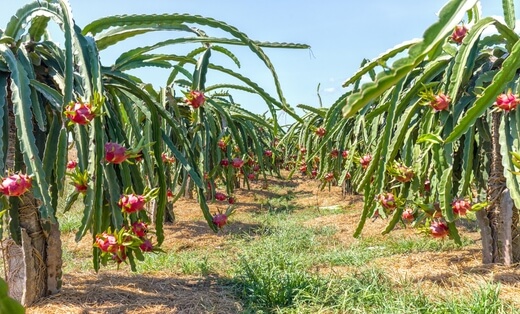
How and Where to Plant Dragon Fruit Cactus
Dragon fruit plants need full sun, good drainage, and occasional but generous watering. When you buy a young plant, it will usually be in a 10-20cm wide pot.
Prepare the planting area by loosening the soil around the planting hole, and adding in even quantities of compost and sand to at least 1 ft deep. Plant the root ball so its surface is level with the soil, and water it in generously.
Soil & Drainage
Choose well-draining soil, and use a standard cactus or succulent potting mix for any plants grown in pots. For Pitaya grown in the garden, dig in plenty of organic compost, and sandy soil so it has enough nutrients to get established, without sitting in water.
Light & Temperature
Dragon fruit plants need full sun. They are tropical plants that can cope with both arid conditions and seasonal change. Provided they get full sun and are never sat in boggy conditions you can grow them almost all year round in most of Australia.
For anyone in Tasmania or cooler parts of the South East, it’s worth growing your dragon fruit cactuses in pots, or in greenhouses, so they can be protected in winter.
Water Requirements
Despite your best instincts, remember that Pitaya, or dragon fruit plants, are cacti. That means they like a lot of water, but not very often. They are used to arid conditions where, when it rains, it pours.
Water once a month, and not at all through winter if you’re bringing them indoors. In warmer parts of the country, try to keep moisture levels low, but even throughout the season as dragon fruit can be pollinated, and produce fruit in four cycles per year.
Propagating Dragon Fruit
As well as being simple to grow, dragon fruit plants are simple to propagate too. All you need is a leaf, some water, and pretty much any soil or compost you can lay your hands on.
It is possible to grow pitaya from seed, but honestly, it’s not worth the hassle. The easiest way to propagate them is with a stem cutting, taken in water, and anyone with a mature cactus should be happy to let you have a tiny piece… if you ask nicely!

Propagating Dragon Fruit Cactus from Cuttings
To take cuttings from dragon fruit plants, the only thing you can really get wrong is size. Cuttings are under immense amounts of stress to support existing foliage, stems, and top growth while they try to develop new roots, so the smaller, the better.
Simply cut a 5-10 cm piece of dragon fruit cactus stem (the green floppy bit) and leave it to callous over for 2-3 days. This prevents it from rotting in the soil. To keep track of ‘up’ and ‘down’, cut a small notch in the base – the end that was closest to the roots.
When it has slightly calloused, drop the end that was closest to the roots into 1cm of clean water, and wait for 1-2 weeks. Roots should appear reasonably quickly, and once there are several roots, and tiny signs of new growth, plant it into any well-draining compost.
Keep it moist, warm, and out of direct light for the next few months, and then begin training it upwards.
These cuttings can often bear small fruit within just 6 months, but it's best to remove the flowers as they form so the plant can focus on establishing roots, and stems for the first two years.
How to Care for Dragon Fruit Cactus
If you’ve got a self-pollinating dragon fruit, planted in a good location, on free-draining soil, there really isn’t very much you need to do to keep it healthy. But, there are some tricks to get bigger fruit, and container-grown plants that will keep them happier for longer.

Dragon Fruit Plant Fertiliser
Always think about fertiliser before buying any plant. What resources have you got already that can save you a few pennies? What fertilisers are easily available locally, or affordable online? More importantly, what’s actually best for the plant?
Well, like any cactus, nitrogen and carbon are the two most important factors in any fertiliser. Forget any fancy NPK-based feed, and stick to basic tropical fertilisers.
If you prefer to grow organically, use chicken manure pellets, or a mulch of organic garden compost (made from a mix of 50% green waste, and 50% brown waste).
Pruning and Repotting
Dragon fruit cactuses don’t particularly like to be pruned, and will often grow off in one direction if they are limited in another. So, to start with, choose a spot where they can be grown in a tree form, or without restriction against a fence or trellis (check our guide for that later on).
Container-grown dragon fruits will need repotting every three years. Their roots aren’t particularly vigorous, but they will send up new shoots and can begin to choke themselves.
Plus, any simple nutrients in the soil will be expended after that time, so refreshing the compost, and jumping up a couple of inches in pot size will help to ripen more fruit.
Pollinating Dragon Fruit Plants
If you’ve bought a Selenicereus undatus type of dragon fruit (the white-fleshed varieties) check whether it is self-pollinating or not. Nearly all red-fleshed varieties are self-pollinating, as are yellow-skinned types, but the white-fleshed varieties can differ from cultivar to cultivar.
Self-pollinating varieties can be grown as individual plants. Others will either need another plant (ideally a self-pollinating variety so you don’t need to worry about sex), or another or the same cultivar of a known sex.
To pollinate, all you’ll need is a paintbrush and a keen eye. As soon as flowers open, go around painting pollen from open male flowers onto open female flowers. For some varieties, this can be male and female flowers on the same plant.
10 Dragon Fruit Trellis Ideas
1. Traditional Dragon Fruit Pole Trellis
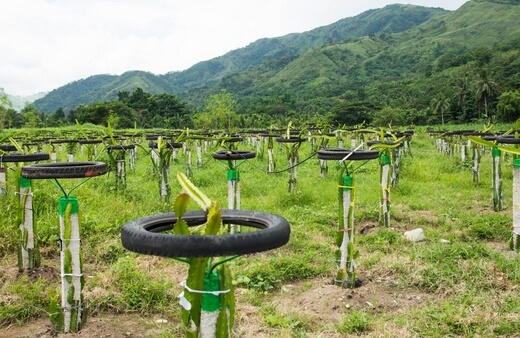
The most common way to grow dragon fruits doesn’t have to be expensive. You can use anything from old scaffolding to lengths of 2x2 timber and an old bike tyre. The idea is to create a 1.5-2m tall pole, which you then tie dragon fruit vines into.
When it reaches the top, simply droop the vines outwards over the rim of their circular, or square, support.
2. Pergola
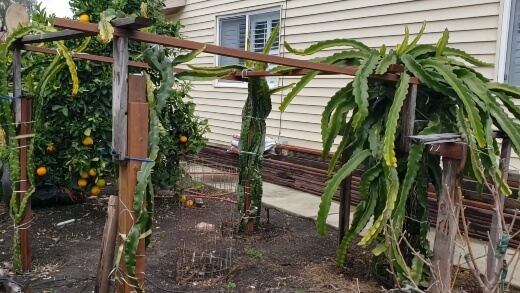
Source: Crime Pays But Botany Doesn't
If you’ve got the space, there’s no more dramatic way to grow dragon fruit than on a pergola. Simply plant cuttings into the ground, four to each post. Eventually, you’ll have a seating area with a canopy of ripe fruit to pick and eat.
3. Pleaching

Source: Dragon Fruit Obsession
While it’s pretty much impossible to pleach a dragon fruit with the same rigour as other fruit trees, the principle of training them out in a fan shape across a fence means more surface area for the sun and a warmer surface for growing tropical plants. Great if you live in the cooler south.
4. Trellis Fencing
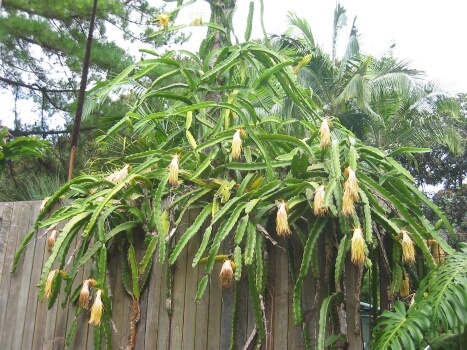
Source: Daleys Fruit Tree Blog
Most gardeners spend too long worrying about how to train dragon fruit, and not enough time enjoying their garden. By using a basic trellis, or slatted fence, you can easily grow dragon fruit and embrace its wild, sprawling nature.
It won’t be the same beautiful, or accessible form as some other methods, but it’s a great way to create tropical screening.
5. Wire Trellis

Source: The Pro Health Shop
Pretty much any support you can muster up for the rubbish in your shed will do as temporary support for dragon fruits. Using old cables, wire, or fruit nettings can create a reasonably long-lasting structure to plant dragon fruit through.
You’ll need to wind the vines manually as they grow, but it can create a stunning landscape feature when it's mature.
6. Tomato Cages
If you’ve got any old tomato cages or garden obelisks, they work surprisingly well as dragon fruit supports. Simply stick them in the ground, or even into the pot you’re growing in, and use twine to attach the vines as they develop.
When the vines reach the top, simply encourage them outwards like you would with more traditional structures.
7. Old Tree Trunks
If you have an old tree that’s been felled, you can use that to tie your dragon fruit cactus to. Using hardwood, like logs from cherry trees, is ideal but any tree that’s been topped and stopped growing can be used even if the roots are still in the ground.
Just make sure that the tree itself has stopped growing before planting anything else alongside it!
8. Fruit Cage
Fruit cages, like those used for any soft fruit to keep birds off, are ideal for dragon fruit. They might not be the most beautiful addition to a garden, but they are practical and help to keep fruit flies and potential birds away from ripening fruit!
9. Hanging Baskets

Source: Wild Fern Indoor Blooms
Dragon fruits, as you might expect, grow exceptionally well in hanging baskets. There are some restrictions and complications, like the size of the pot, and how it will restrict growth after three years, but if you have a strong enough support for the hanging basket, you can use bigger and bigger pots as the plant develops to avoid the need for complicated structures and permanent planting. Ideal for larger plants that need to overwinter in cooler climates!
10. No trellis
This is potentially a bit too bold, but if you’ve got the space, why not go back to nature? Dragon fruit plants don’t need a trellis or support to thrive and will create beautifully weird, twisted mounds of trailing vines if left to their own devices on well-drained soil, or even a sandy rockery.
Just keep an eye out for bacterial problems as their soil will be effectively mulched by the plant itself, causing higher water retention.
Don't miss our list of garden trellis ideas and kits you can use for other plants you are planning to grow in your garden.
Harvesting Dragon Fruit

How and When to Harvest Dragon Fruits
Dragon fruits are ready to harvest as soon as their skin colour reaches its full intensity. They will be slightly soft to squeeze and will drop from the plant when gently rocked back toward the stem.
Try not to pull, or force them away from the stem, as dragon fruits picked unripe do not develop flavour off the cactus and will be virtually tasteless!
The Best Way to Store Dragon Fruits
There are two ways to store dragon fruit, and neither is rocket science. Dragon fruit stores best in the fridge, and will keep for up to two weeks. Once over-ripe, their flesh will begin to turn brown. It’s still edible but can have a grainy texture.
My favourite way to store dragon fruits is to allow them to ripen in a bowl for a few days off the plant, and then scoop out the flesh into neat cubes and freeze it. It’s perfect for smoothies and even as ice cubes in cocktails and will last for at least six months.
Dragon Fruit Plant Pests and Diseases
Dragon fruit plants are susceptible to the same range of succulent pests as any other tropical plant; aphids, thrips, moths, scales, spider mites, and mealybugs, but they won’t cause significant damage if they are washed off when noticed.
The bigger problem is the fruit pests, like fruit flies, beetles, snails, slugs, and stink bugs.
(Join Nathan as he guides you through the proper steps to eliminate stink bugs.)
Normal garden pests
Most garden pests (the honeydew producing types) will head straight for succulents if they have a chance, so they will be attracted to any new growth on your dragon fruit plants. Keeping the plants happy, healthy, and well-drained is key to not exacerbating the problem.
If you notice an infestation of anything like aphids, mealybugs, spider mites, scales, or caterpillars, simply spray them off with a hose, and treat the plant with diluted neem oil to prevent a recurrence.
Fruit pests
Fruit pests, like stink bugs, fruit flies, beetles, slugs, snails, and even wasps can cause havoc when dragon fruits are left on the plant past ripening. They rarely cause problems with unripe fruit, so harvesting quickly is a must.
There are four key groups of viruses to look out for with any cacti, but thankfully they are rarely affected by fungal or bacterial problems, so other than potential root rot in damp conditions, the key signs of diseases on dragon fruit plants are above-ground, making them much easier to fix.
Anthracnose virus
The only common fungal problem in cacti is Anthracnose, which overwinters in the soil, on dead leaves, and even on seeds from infected plants. Essentially, it produces brown dead patches on the stems of cacti and is spread by passing insects or even dirty tools.
Cut off any infected section of the plant and burn it to prevent cross-infection or spread.
Stem canker
Canker isn’t one disease, but many. Essentially, any part of the stem which developed dry, hollow lesions is referred to as a canker. They are usually bacterial infections that cause necrosis (dead tissue). Known effects include the dying back of material above the canker as nutrients can’t pass it.
Treatment is pretty simple; just remove the canker and about 15cm of the plant below that line. This obviously means losing anything above it, but it will prolong the life of your cactus so is ultimately worth it.
Cactus viral disease (Cactus virus X)
Cactus viral disease or Cactus virus X is an unhelpfully named viral infection that causes yellowing stems, twisted, or distorted growth, and, sadly for dragon fruits, failed pollination due to bloom drop.
Current cures for CVX are unproven, but anecdotally, scrubbing early signs of infection with insecticidal soaps like neem oil, horticultural soap, or castile soap can dry out and stop its spread.
Bipolaris cactivora
While it does affect most genera of cactus, Bipolaris cactivora is a fungal pathogen that actively consumes the flesh inside the stems and fruits of Pitaya (dragon fruits).
External symptoms are brown lesions, and divots in the stems of fruit, with dusty surfaces. Internally, the flesh will appear brown and rotten. Treat the area and any nearby plant with a general-purpose organic fungicide, and burn the directly affected materials.
Dragon Fruit Plant Frequently Asked Questions
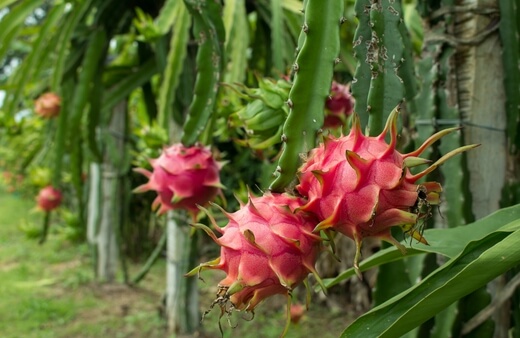
How long do dragon fruits take to grow?
Dragon fruit plants can produce fruit within 6 months from cuttings, but it's best to remove them and encourage stem and root development. After two years, your cactus stems will be mature enough to cope with a full crop of fruit.
Can you grow dragon fruit indoors?
Dragon fruit cactus works well indoors, and can be trained up staircases, or around brightly lit windows for some indoor gardening. Simply provide free-draining soil with plenty of nitrogen, and try to shade the roots, while providing as much sun as possible to the vining stems.
How many times a year do dragon fruit cactuses flower?
Dragon fruit plants, once established, can produce four flushes of flowers, and fruit, per year throughout Australia. The beauty of our more northern climates is that they match the tropical conditions, without the completely arid nature of some of their natural habitats.
What is the best time of year to plant dragon fruit?
Dragon fruit cactuses can be planted at any time of year. There is no right or wrong time to plant a dragon fruit cactus as they are active nearly all year round, and will continue growing as soon as you plant them in a new pot, or into garden soil.
Start Growing Dragon Fruit Plants and Enjoy its Delicious Fruits in Your Garden
Dragon fruits are amongst the most spectacular tropical plants you can grow at home, and if you’ve got the right outdoor climate will be a defining plant in your garden, with 5m long vines that can be trained up walls, trellis, or even as self-standing tree-like structures.
Even in smaller gardens, choosing smaller varieties that work well in hanging baskets means you can grow these stunningly sweet fruits at home all year round. And now you know how to grow dragon fruit plants, you’ve got no excuse, so go out and find your perfect plant.
Published on December 7, 2022 by Maisie Blevins
Last Updated on February 22, 2024





Hi there, my friend has given me his matured cuttings (Stem Cuttings) I’ve plant plant them in the ground for maybe 2 weeks now. I know it’s winter now so maybe a slow reaction for the plant. But all I can’t visually see is it’s getting skinny I don’t know if the roots have developed yet please help Vinnie thanks
Hi Vinnie,
By ‘getting skinny’, do you mean its stem is shrivelling? It’s really quite likely if it’s been planted into new soil in winter, particularly if it’s outdoors, because it will be dormant. The best time to plant any dragon fruit plant out is mid-late spring when the roots, stems and everything else is starting to grow.
If you can, I’d suggest bringing it indoors, with as much of the existing soil as possible, and trying to trigger it back into growth with light and heat so it thinks it is spring. It’s not guaranteed, but it’ll have a better chance than if it stays in a dormant state outdoors for the whole of winter.
Good luck!